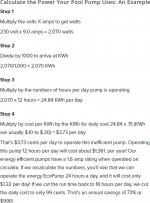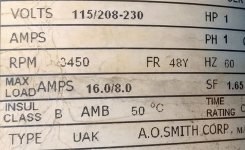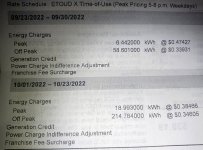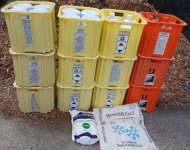Gary Davis
Well-known member
I want to say that I don't know what I'm talking about when it comes to SWCG but I do know California electricity rates.Your electricity costs would depend on your pump, and your rates which you provided.
I think we can safely say California electricity rates are somewhere between 35 and 40 cents per kilowatt-hour, on average.
I don't know what other states are in terms of electricity rates, but I suspect California is on the high end (by a lot), is it not?
That means electricity, if it's increased when a SWCG is put in, is a factor that may need to be considered in the total cost equation.
I don't know much about the pumps as I almost never use them (so I took a picture of the spec plate and posted it below).The electricity used depends on the HP of the pumps.
The pumps are the AO Smith QC1102 single-speed model (about two decades old) and they are listed as 1 HP but they also have a 1.0 x 1.65 service factor so maybe I should call it a 1-1/2 horsepower 220VAC pump? I don't know.
The amps are written as 16/8 so am I to assume it's 8amps for me since they're wired at 220VAC?
Googling for how to calculate the electricity consumed I found this explanation which I will run for just one of my two pumps.
- Multiply the volts times amps to get watts
- (their example) 230 volts x 9.0 amps = 2,070 watts
- (my example) 230 volts x 8.0 amps = 1,840 watts
- Divide by 1,000 to arrive at KWh
- (their example) 2,070/1,000 = 2.070 KWh
- (my example) 1,840/1,000 = 1.840 KWh
- Multiply by the numbers of hours per day pump is operating
- (their example) 2.070 KWh x ~12 hours = ~24.84 KWh per day
- (my example) 1.840 KWh x ~12 hours = ~22.08 KWh per day
- Multiply by cost per KWh by the KWh for daily cost
- (their example) = 24.84 KWh x ~.15 = ~$3.73 per day
- (my example) = 22.08 KWh x ~.40 = ~$8.83 per day
- Multiply by 30 for the monthly cost
- (their example) $3.73 per day x 30 days = ~$112/month
- (my example) $8.83 per day x 30 days = ~$265/month
Given the pool has one pump for both the skimmers and popups (which are unfiltered) and another pump for the filtration, the cost is somewhere more than that but I don't know if the SWCG would be attached to the popup/skimmer or filtration pump (both of which are exactly the same).
That's a good number since we can take your rate of around $400 and mine of around $600 to average to about $500.The SWG itself uses $414 worth of electricity to create the 580 pounds of chlorine that my SWG cell is rated for, so basically the life of cell.
My electricity costs is 25 cents per kWH, so less than your rates. Figure you'd pay about $600 for the electricity for the SWG plus cost of running the pump.
Given we want to be useful to everyone who reads this, is about $500/year on average a good-enough number to use for the additional electrical cost of adding SWCG?
I don't know as the solution I use to high electrical rates is to use less electricity and more elbow grease to take care of the pool.LA DWP had a great rebate to convert to a VSP, does your electric company offer a rebate?
- I brush the floor to push bottom debris to the deep end (wide steel brush on a pole)
- I then skim the surface manually (wide skimmer on a pole) because brushing kicks up debris in the shallow end
- When the dust settles, I vacuum the deep end floor manually (six-inch garden hose type on a pole with a bag)
- When I add chemicals, I brush the floor a bit to stir up the water (plus I dilute like crazy - much more than most people do)
The real problem is the capital needed, but of course, I can look out five years (or so) to find a break-even point where you save money in the end.
- That's really the answer to the SWCG question I'm after.
- Does SWCG save money in the end, or not?
Other solutions, of course, for the high electrical rates are solar - but I don't have the capital for that and I don't have the right kind of roof either for the ones that someone else puts in for you; so it has to be on the ground.
And of course, I can invest capital in variable speed motors (of which I have three motors to replace, one for the spa, but which I never use).
If they have variable speed SOLAR powered 1.5 HP pump motors... that might be the way to go (do they exist?).
But all I want to arrive at for a SWCG calculation is how much more does SWCG cost in electricity over the expected lifetime.
That's all.
When I bought the house, they said to run the skimmer/popup pump half the time that I run the filtration pump.Do you have to run both pumps, or can you just run the circulation pump?
The skimmer/popup water is unfiltered (except for baskets) where it's pulled out of the two skimmers at the surface and then it goes to the pump and then from the pump it goes to the water valve space ship which is the set of controls as not all popups work at the same time and from there it goes to the popups in the floor of the pool to circulate the water in a series of a few jets at a time, which rotate on their own over time.
The filtration pump setup is much simpler as it merely takes the water from the floor of the spa and the floor of the deep end and then it goes to the pump and then to the filter space ship and then back to the surface via jets at the deep end and inside the spa (each set controlled by a jandy valve that diverts the return flow as desired).
The word "circulate" is complicated in this situation because the popups actually do all the circulation but none of the filtration.If you just needed one to circulate water for the SWG, and you convert to VSP, might still save money.
I don't know how a SWCG would be inserted into a self-cleaning arrangement such as mine is.
- Does a SWCG get inserted into the filtration system or into the circulation system?
Attachments
Last edited:







